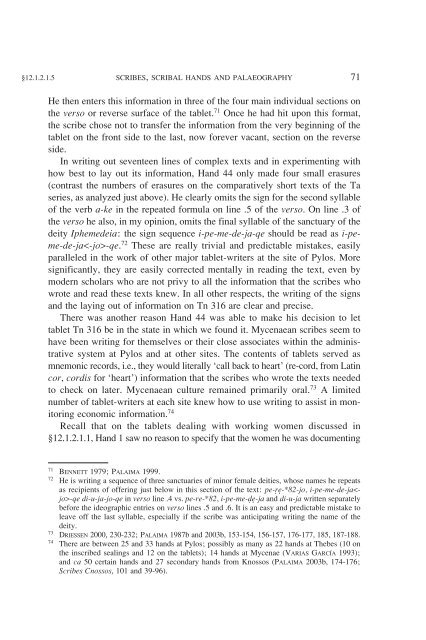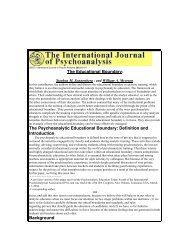A Companion to Linear B - The University of Texas at Austin
A Companion to Linear B - The University of Texas at Austin
A Companion to Linear B - The University of Texas at Austin
You also want an ePaper? Increase the reach of your titles
YUMPU automatically turns print PDFs into web optimized ePapers that Google loves.
§12.1.2.1.5 SCRIBES, SCRIBAL HANDS AND PALAEOGRAPHY 71<br />
He then enters this inform<strong>at</strong>ion in three <strong>of</strong> the four main individual sections on<br />
the verso or reverse surface <strong>of</strong> the tablet. 71 Once he had hit upon this form<strong>at</strong>,<br />
the scribe chose not <strong>to</strong> transfer the inform<strong>at</strong>ion from the very beginning <strong>of</strong> the<br />
tablet on the front side <strong>to</strong> the last, now forever vacant, section on the reverse<br />
side.<br />
In writing out seventeen lines <strong>of</strong> complex texts and in experimenting with<br />
how best <strong>to</strong> lay out its inform<strong>at</strong>ion, Hand 44 only made four small erasures<br />
(contrast the numbers <strong>of</strong> erasures on the compar<strong>at</strong>ively short texts <strong>of</strong> the Ta<br />
series, as analyzed just above). He clearly omits the sign for the second syllable<br />
<strong>of</strong> the verb a-ke in the repe<strong>at</strong>ed formula on line .5 <strong>of</strong> the verso. On line .3 <strong>of</strong><br />
the verso he also, in my opinion, omits the final syllable <strong>of</strong> the sanctuary <strong>of</strong> the<br />
deity Iphemedeia: the sign sequence i-pe-me-de-ja-qe should be read as i-peme-de-ja-qe.<br />
72 <strong>The</strong>se are really trivial and predictable mistakes, easily<br />
paralleled in the work <strong>of</strong> other major tablet-writers <strong>at</strong> the site <strong>of</strong> Pylos. More<br />
significantly, they are easily corrected mentally in reading the text, even by<br />
modern scholars who are not privy <strong>to</strong> all the inform<strong>at</strong>ion th<strong>at</strong> the scribes who<br />
wrote and read these texts knew. In all other respects, the writing <strong>of</strong> the signs<br />
and the laying out <strong>of</strong> inform<strong>at</strong>ion on Tn 316 are clear and precise.<br />
<strong>The</strong>re was another reason Hand 44 was able <strong>to</strong> make his decision <strong>to</strong> let<br />
tablet Tn 316 be in the st<strong>at</strong>e in which we found it. Mycenaean scribes seem <strong>to</strong><br />
have been writing for themselves or their close associ<strong>at</strong>es within the administr<strong>at</strong>ive<br />
system <strong>at</strong> Pylos and <strong>at</strong> other sites. <strong>The</strong> contents <strong>of</strong> tablets served as<br />
mnemonic records, i.e., they would literally ‘call back <strong>to</strong> heart’ (re-cord, from L<strong>at</strong>in<br />
cor, cordis for ‘heart’) inform<strong>at</strong>ion th<strong>at</strong> the scribes who wrote the texts needed<br />
<strong>to</strong> check on l<strong>at</strong>er. Mycenaean culture remained primarily oral. 73 A limited<br />
number <strong>of</strong> tablet-writers <strong>at</strong> each site knew how <strong>to</strong> use writing <strong>to</strong> assist in moni<strong>to</strong>ring<br />
economic inform<strong>at</strong>ion. 74<br />
Recall th<strong>at</strong> on the tablets dealing with working women discussed in<br />
§12.1.2.1.1, Hand 1 saw no reason <strong>to</strong> specify th<strong>at</strong> the women he was documenting<br />
71 BENNETT 1979; PALAIMA 1999.<br />
72 He is writing a sequence <strong>of</strong> three sanctuaries <strong>of</strong> minor female deities, whose names he repe<strong>at</strong>s<br />
as recipients <strong>of</strong> <strong>of</strong>fering just below in this section <strong>of</strong> the text: pe-®ê-*82-jo, i-pe-me-de-ja-qe<br />
di-u-ja-jo-qe in verso line .4 vs. pe-re-*82, i-pe-me-∂ê-ja and di-u-ja written separ<strong>at</strong>ely<br />
before the ideographic entries on verso lines .5 and .6. It is an easy and predictable mistake <strong>to</strong><br />
leave <strong>of</strong>f the last syllable, especially if the scribe was anticip<strong>at</strong>ing writing the name <strong>of</strong> the<br />
deity.<br />
73 DRIESSEN 2000, 230-232; PALAIMA 1987b and 2003b, 153-154, 156-157, 176-177, 185, 187-188.<br />
74 <strong>The</strong>re are between 25 and 33 hands <strong>at</strong> Pylos; possibly as many as 22 hands <strong>at</strong> <strong>The</strong>bes (10 on<br />
the inscribed sealings and 12 on the tablets); 14 hands <strong>at</strong> Mycenae (VARIAS GARCÍA 1993);<br />
and ca 50 certain hands and 27 secondary hands from Knossos (PALAIMA 2003b, 174-176;<br />
Scribes Cnossos, 101 and 39-96).

















